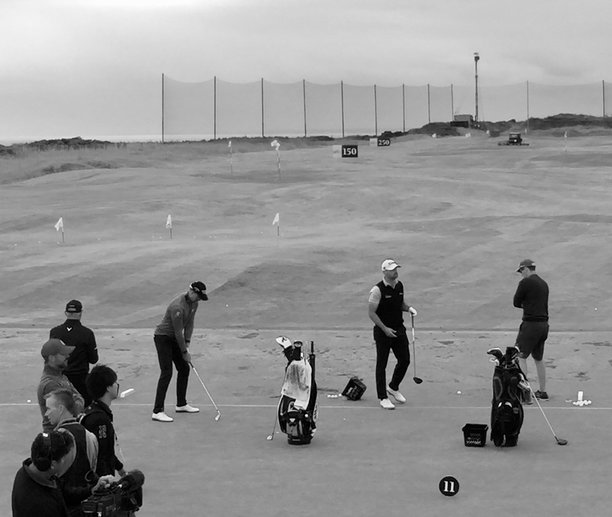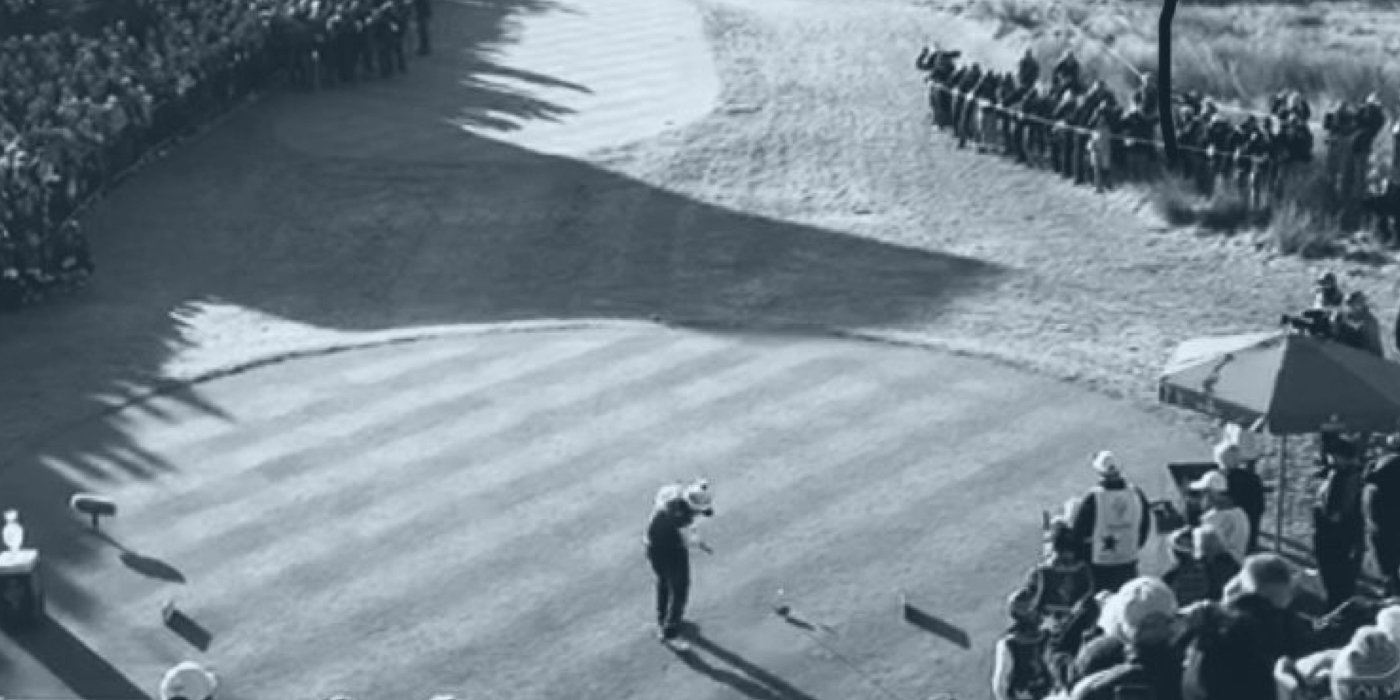In this article, we’ll explain how to prepare for a golf tournament. We cover the exact approach I take with the elite players and outline some top tips to help you optimise your performance – I hope it serves you well.
There are three key areas:
First, we’re going to cover course strategy as this will inform your pre-tournament practice and in-play decision making.
Our aim throughout this process is to build a simple, clear plan. This approach ensures that when you are on the 15th hole of your event, heart pumping, and you have a 9-iron in hand there is no second-guessing that your target is the middle of the green, 30-feet left of the hole.
The clarity that many golfers are looking for when executing golf shots is a function of great preparation. It is a well-kept secret that isn’t often discussed in detail.
Let’s show you how to prepare like a pro.
Table of Contents
Course strategy & the grand plan

Many problems can be made easier by looking at them backwards. In golf, the best way to create a plan is to start with the end goal – what is the winning score likely to be?
Once you have this information everything can be built around getting you to that target. For professional events, we rely on previous winning scores, for a club event you may also want to look at previous winning scores, see if +1 or -3 has won the club championships over the past 5 years.
For handicap events you may estimate 6 under will give you a strong chance, therefore shooting +10 with your handicap of 16 should be your target.
Average score per round
With this information, you can now figure out the average score you need to shoot for every round. In the picture above and video example I’m sharing below -13 won the three round event. This means we need to create a strategy to shoot -4.3 per round to have a strong chance of winning.
We’ve now got a concrete base to build from. How we achieve this depends on you as the player – nine birdies and four drop shots a round would work, however, a steady round of five birdies and no drop shots will be just as effective.
Which approach you select will now inform every target you choose and every shot you hit in your tournament. The player in our video example below is a very solid ball striker, particularly good with his irons from 120 – 200 yards. Based on this we identified a more conservative strategy off the tee and into greens, minimising drop shots and aiming to convert birdies where he can.
Identifying tough and easy holes
The next step is to look out for any particularly challenging and easy holes. Previous data is again helpful, but data normally just confirms what we already know. For these tough holes work out your best strategy.
If you are allowed to drop 10 shots in a round it is probably a good idea to play for a 5 on a very tough par 4 if it takes a big score out of the equation. Other times tough holes simply require you to stand up and deliver a great shot, in this case, we’ll make sure we practice these shots as much as we can in the lead up to the event, more on this later.
Easy holes don’t always call for overly aggressive plays either. Play to your strengths and choose strategies that will give you the lowest average score over 10 attempts at a given hole. This approach is statistically your best chance of optimum scoring.
If this is your home course and you’re not sure what strategy is best, play the hole five times with one strategy, five times with a different strategy and work out your average score for both approaches – you might be surprised!
On course strategy
Once you’ve completed the steps above it is time to plan a strategy for each hole. Here is a link to a full guide on on-course course strategy and management for you to read. But summarising quickly, you plan each hole backwards and focus on landing zones off the tee and into the greens, rather than specific clubs to hit.
Putting this all together
Here is a quick video to demonstrate how this all looks when we have some basic data to work with. A big thanks to the pro I work with who kindly let me share this with you all.
Again, this is mostly common sense, but great performances are built upon doing all the basics very, very well.
After a request from a reader here is a link if you’d like to download this spreadsheet for your own use.
Modifiers & elite prep
I should note there are two main modifiers to the process and scoring estimates outlined above:
- Weather conditions
- Course conditions
If the wind picks up scores worsen quickly, this can often be predicted a day or two before the event, resulting in an adaptive strategy. Thick rough and firm greens are the two biggest on course modifiers, again 1-2 days before the event you can start to get a sense for how the course will play.
These can both be estimated and factored in. Your prediction doesn’t have to be perfect, rather, your aim is to stand on the 1st tee better prepared and with a stronger game plan than any other player on that day.
Elite amateurs and pros should also consider using the Windy App and Google Earth to check out wind strength and the holes that will be playing into, across and downwind before each day of play.
Practice before the golf tournament
There are two main parts to pre-tournament practices to master – practice rounds and off-course practice.
Practice rounds
During practice rounds, you are trying to nail down targets and landing zones off every tee and into every green. Where you can try out different clubs off the tee and find out where it leaves you on a given hole.
As you approach the greens try to fit in extra chips, pitches and bunker shots from the locations your ball is likely to finish in.
Finally, consider where the flags are likely to be over the event. If you are lucky these are sometimes marked with spray paint the day before. Hit putts from the centre of the green to these locations. Then hit a few 3 to 10-feet putts around these locations to build up a sense of the break around the hole.
Finally, work out the places you definitely can’t miss off the tee and into the green. Mark these with a big ‘X’ in your course planner and choose targets that are further away from these locations to give you more margin for error.
We call these target modifiers and the 17th hole on The Castle Course is quite an extreme example – a 184 yard Par 3 where a shot finishing short or right is dead. For more on target modifiers check out this podcast with Connor caddying on the European Tour.

Off course practice – Tournament prep
Most pros I work with have 1-2 days to prepare for each event, including a practice round and possibly a pro-am, leaving 3-5 hours for off-course prep and conditioning work. Factor in 5-20 hours travelling the day before and you realise time is very precious leading up to events and rest is also essential.
It is up to you how you spend your prep tournament practice time, but the aim is to get your game in tiptop shape for your competition.
Another secret I can share is that even when players win professional events they rarely go into the event with all areas of their game firing, so don’t worry if you are struggling with your iron play or bunker shots. You can still win, just use this time pre-tournament as effectively as you can.
Below are my three key tips to help you get in a performance mindset running up to the tournament:
#1 Play skills games
Pick a handful of skills games you can play beforehand. Your aim when playing skills games is to maximise your score, it doesn’t matter how ugly the swing or shot is, just find a way to get your golf ball to your target. Amateur golfers love spending time perfecting their swing on the golf range, but are often guilty of not taking part in this type of gritty practice – this practice is crucial for tournament prep.
Hopefully, you have your own favourite skills games, if not check out the links below for some ideas:
#2 Practice key shots
What shots are most important to your scoring? Is it a tight driving course? Will you be leaving yourself lots of long and mid-irons into the greens, or will you have lots of 30 – 80 yard shots? What type of shots around the green will come up? Just make sure you practice and feel comfortable with the essential shots for your chosen strategy.
#3 Keep on top of your basics
Finally, keep on top of your basics for long game, short game and putting. Grip, alignment and posture are the glue that holds together golfing technique. 10-30 minutes with an alignment stick on the range and a good putting aid on the green are all you need.
On the day & in-play decision making
On the day of your tournament you’ll ideally turn up with some time to spare – arriving 5 hours early is almost as bad as having just 10 minutes to spare, so aim for a time that allows you to have a focused warm-up and a little time to spare (45 minutes to 2 hours).
Your aim is not to work on your golf swing mechanics, it is to warm up, see where your shots are going, and to feel as comfortable as you can. If you’re having a bad day, hit 10 shots on the range with your 7-iron and driver, if on average your shots are finishing 15-yards right then this is what you are playing with today – factor it into every shot!
Too many golfers become over-technical just before big events and try to fix errant shots. Better players play with what they have on the day and fix issues after the round. Check out the following links for more on creating an simple warm-up routine and a guide to golf stretches.

How to play well during the golf tournament
Once the tournament begins it is all about executing one shot at a time. All the work you’ve done beforehand should mean you have a clear, simple plan. You know where you are aiming off every tee and where you are aiming into every green.
Your process
It is now about:
- Locating your target, adjusting for wind and swing
- Selecting your club and swing needed
- Sticking to your pre-shot routine
- Executing
- Finding your ball and repeating.
When you get in trouble, just get yourself back in play and as best as possible continue with your plan.
I know when reading this you’ll want more information, but the secret isn’t in having more ideas. Instead, the secret is in mastering this very simple process. If you can rate this sequence out of 10 on every shot and mark it on your scorecard you’ll quickly see how this translates into performance.
Your mindset
See each tournament as a chance to learn more about how to play great golf under pressure. This focus of seeing tournament play as a learning experience, rather than about the end result can be a really useful strategy for many players who say they struggle to perform under pressure.
If you are playing a 36 or 54 hole event just remember that you can’t win the tournament in the first 9 or 18 holes, but you can lose it. Keep focused on your strategy, avoid risky shots and the results will come as your statistically sound strategy compounds over time.
Summary
90% of playing well in a tournament is a result of what you do beforehand. In this guide, we’ve covered tournament strategy, practice round prep, off-course prep and what to do on the day of your event.
It is genuinely the best information I have to offer, so I sure hope it helps you perform when you need it most. If you’d like to say thanks just share this with fellow golfers or around the web – I appreciate all the help in getting this out there to more players.
Also if you would like more articles like this one come join the Golf Insider weekly post.
Happy golfing – Will @ Golf Insider UK


Not bad advice
But must add it’s THE Open not the British open
Thanks Wayne,
I’ll work it into the next update.
I hope the golf is going well.
Will
This is a great spreadsheet for analysis. Any chance of getting template to work with? Thanks in advance for your time. Cheers. /D